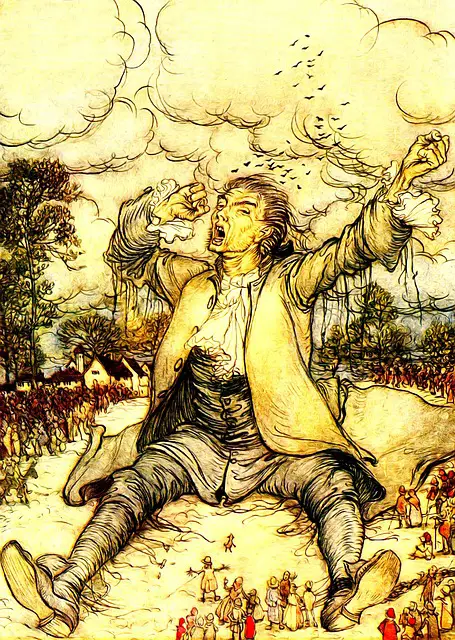In Gulliver’s Travels, Lilliputians are a race of tiny people who live on the island of Lilliput, while Brobdingnagians are a race of giant people who live on the island of Brobdingnag. The Lilliputians are portrayed as being petty and power-hungry, while the Brobdingnagians are portrayed as being kind and wise.
Lilliputians and Brobdingnagians
(Image by Prawny from Pixabay )

In the story “Gulliver’s Travels,” the protagonist, Lemuel Gulliver, encounters two different sets of people: the Lilliputians and the Brobdingnagians. The Lilliputians are a race of tiny people who live on an island called Lilliput. They are only about six inches tall. The Brobdingnagians are a race of giants who live on an island called Brobdingnag. They are about 60 feet tall.
Both the Lilliputians and the Brobdingnagians are amazed by Gulliver because he is so different from them. The Lilliputians think that he is a giant and the Brobdingnagians think that he is a small person. Gulliver has many adventures with both groups of people, but he eventually returns to his own country.
How do Lilliputians and Brobdingnagians each represent a different way of viewing humanity?
In Gulliver’s Travels, Lilliputians and Brobdingnagians each represent a different way of viewing humanity. The Lilliputians are a satirical representation of the small-mindedness, pettiness, and political corruption of 18th-century England. They are portrayed as being obsessed with power and prestige, and are willing to go to great lengths to maintain their status, even if it means engaging in war and other forms of violence. They are also shown to be very concerned with social status, and are obsessed with protocol and ceremony.
On the other hand, the Brobdingnagians are a representation of the wisdom and kindness of humanity. They are portrayed as being much larger than Gulliver, and are shown to be much more rational and understanding than the Lilliputians. They are shown to be deeply concerned with the well-being of others, and are shown to be much more peaceful and less obsessed with power and status. They are also shown to be very rational and objective in their thinking, and are able to see the world in a much more realistic and unbiased way.
Overall, both Lilliputians and Brobdingnagians are used by Jonathan Swift as literary devices to highlight different aspects of human nature, and to satirize the societal issues of his time. The Lilliputians representing the negative aspects of humanity while the Brobdingnagians representing the positive aspects of humanity.
How Gulliver is different from what Lilliputans and Brobdingnag represent?
Firstly, Gulliver is an outsider, he is a human from England and is visiting both the Lilliputian and the Brobdingnagian societies. He is able to observe the customs and societies of these people from an objective perspective, while the Lilliputians and Brobdingnagians are fully immersed in their own cultures and societies.
Secondly, Gulliver is portrayed as being more rational and objective in his thinking compared to the Lilliputians, who are obsessed with power and status, and engage in war and other forms of violence. Gulliver is also more rational and objective compared to the Brobdingnagians, who are deeply concerned with the well-being of others, and are shown to be much more peaceful and less obsessed with power and status.
Thirdly, Gulliver is not immune to the flaws of humanity and he is portrayed as having his own set of flaws and prejudices, as he often criticizes the societies he encounters. He is not a perfect character and is also shown to have a tendency to be self-centered and boastful.
Overall, Gulliver serves as a representation of the human perspective, with its own set of flaws and biases, while Lilliputians and Brobdingnagians represent different aspects of human nature. Gulliver’s perspective allows the reader to see how these societies function and how they differ from their own societies, and his own flaws serves as a reminder that no one is perfect.
How are the people of Brobdingnag different from the people of Lilliput?
- Size: The people of Brobdingnag are giant in size compared to the people of Lilliput, who are tiny.
- Nature: The people of Brobdingnag are portrayed as kind, wise, and compassionate, while the people of Lilliput are portrayed as petty, power-hungry and corrupt.
- Society: The society of Brobdingnag is portrayed as more peaceful and less obsessed with power and status compared to the society of Lilliput, which is constantly at war and is obsessed with protocol and ceremony.
- Political Systems: Brobdingnag is portrayed as having a more benevolent monarchy than Lilliput which is corrupt and more interested in power and prestige.
- Objective thinking: The people of Brobdingnag are shown to be much more rational and objective in their thinking, while the people of Lilliput are more narrow-minded and obsessed with their own status.
- Attitude towards Gulliver: The people of Brobdingnag are shown to be more accepting of Gulliver as a stranger, while the people of Lilliput are more suspicious and fearful of him.
Attitude towards other people: The people of Brobdingnag are shown to be more concerned with the well-being of others, while the people of Lilliput are more focused on their own interests and status.
Who is Gulliver’s main enemy in Brobdingnag?
Gulliver’s main enemy in Brobdingnag is the giant ogre who lives in the forest. The ogre is twice as big as Gulliver and has a huge mouth that can eat Gulliver in one bite. The ogre is also very strong and can crush Gulliver with ease.
Who was Gulliver’s biggest enemy in Lilliput?
Gulliver’s biggest enemy in Lilliput was the Lilliputian emperor. The emperor was a short, thin man who was very vain and power-hungry. He was always trying to find ways to make himself look taller and more impressive, and he was always trying to get Gulliver to do things that would make him look foolish or weak.
What are the two parties of Lilliput?
In Lilliput, there are two political parties: the Big-Endians and the Little-Endians. The Big-Endians are so named because they believe that the big end of an egg should be opened first, while the Little-Endians believe that the small end should be opened first.
The two parties have been in conflict for many years, and this has led to a lot of violence and bloodshed. The main difference between these two parties is their beliefs about how to eat an egg.
What does the Lilliputians size symbolize?
In the book “Gulliver’s Travels”, the size of the Lilliputians is used to symbolize the smallness and insignificance of humans in comparison to other creatures or objects. This is seen in how they are able to be easily overpowered and controlled by Gulliver, who is much larger than them. Additionally, their small size also makes them appear comical and ridiculous, which further emphasizes the theme of human folly.
What is unusual about the Lilliputians?
There are several things that make the Lilliputians unusual. First, they are very small. In fact, they are so small that they can only be seen by using a magnifying glass. Second, they have a very strange diet. They eat mainly insects and worms. Third, they have a very strange way of communication. They speak in a very fast, high-pitched voice that is almost impossible for humans to understand. Finally, the Lilliputians are extremely strong. They can lift objects that are many times their own weight.
What does size represent in Gulliver’s Travels?
In Gulliver’s Travels, size represents a number of different things. For the Lilliputians, size represents power. They are able to control Gulliver because he is smaller than they are. Size also represents strength and bravery for the Lilliputians. They are not afraid to fight against the Brobdingnagians even though they are much larger. For the Brobdingnagians, size represents a number of different things as well. Firstly, size represents strength. The Brobdingnagians are able to defeat the Lilliputians because they are so much larger. Secondly, size also represents wisdom. The Brobdingnagians are able to see through Gulliver’s lies and tricks because they are much more intelligent than he is.
What are 3 themes addressed in Gulliver’s Travels?
The three themes addressed in Gulliver’s Travels are:
- The theme of growth and development. This is seen in the way that Gulliver grows and develops as a character throughout the course of the novel.
- The theme of human nature. This is seen in the way that both the lilliputians and the brobdingnagians are portrayed as being flawed and imperfect.
- The theme of satire. This is seen in the way that Swift uses satire to criticize various aspects of society, including politics, religion and science.
What is the moral lesson in Gulliver’s Travel?
The moral lesson in Gulliver’s Travels is that pride comes before a fall. This is demonstrated by the character of Gulliver himself, who is initially very proud of his accomplishments and status in society. However, after being shipwrecked and waking up in Lilliput, he finds himself in a country where he is considered a giant. He is then captured and put on display for the Lilliputians to gawk at. He eventually escapes and returns to England, only to find that his wife has left him and his children don’t recognize him. From this experience, Gulliver learns that pride can be detrimental to one’s well-being, and that it’s important to be humble.
Another lesson is that human society is flawed and that individuals should be more critical of their societal institutions and beliefs. The book satirizes the political and social institutions of its time, and suggests that people should be more open-minded and less dogmatic in their thinking. Additionally, the book also critiques the human tendency towards excessive pride and self-importance.
What does Gulliver learn?
Throughout Gulliver’s travels, the protagonist Lemuel Gulliver learns many lessons. Some of the main takeaways include:
- The flaws of human society: Gulliver’s visits to different fantasy lands expose him to a variety of perspectives that challenge his previous beliefs and force him to question the society he comes from.
- The dangers of extremism and narrow-mindedness: Gulliver encounters societies that are excessively devoted to one particular aspect of life, such as science or politics, which leads to their downfall.
- The importance of humility and moderation: Gulliver learns that excessive pride and self-importance can lead to negative consequences.
- The relativity of values: Gulliver’s travels show him that what may be considered normal or morally right in one society may be considered strange or wrong in another.
- The possibility of different ways of living: Gulliver experiences different cultures and ways of living which shows him that there is not one correct way of living, and that there are different ways of organizing society.
Overall, Gulliver’s travels is a satirical work that critiques human society, its institutions and the flaws of human nature. Through Gulliver’s experiences, the author Swift is pointing out the faults in the 18th century society and encourages readers to look at things from different angles and to be more open-minded.
Featured Image By – Breve Storia del Cinema on Flickr









